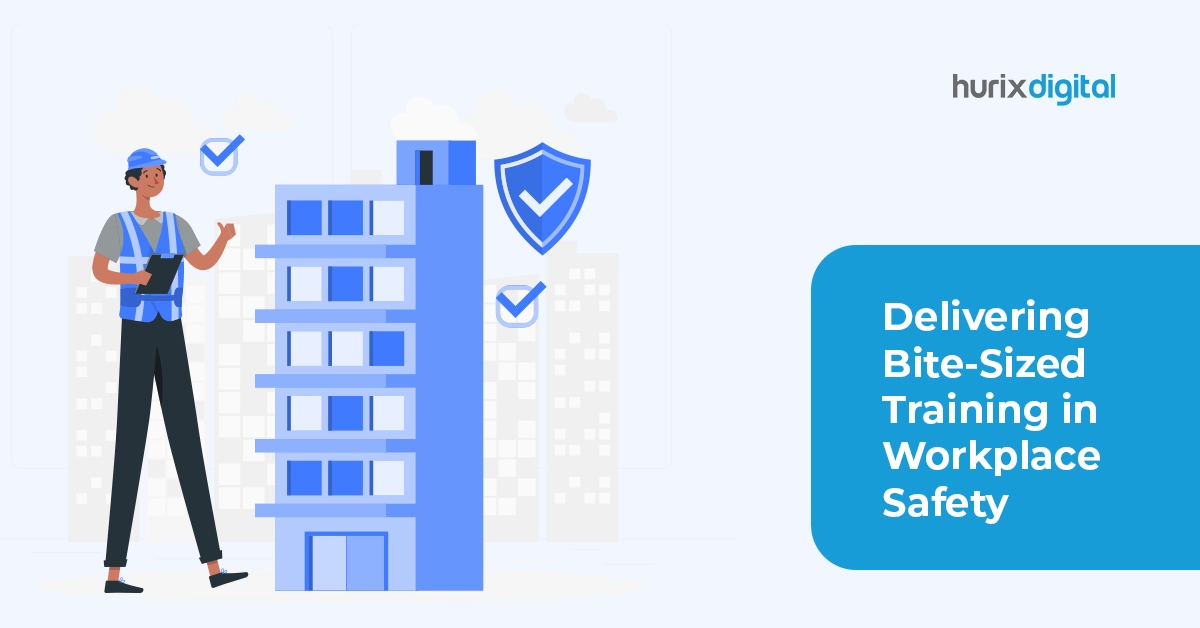
Delivering Bite-Sized Training in Workplace Safety
Every industry, from physical labor to digital services, carries an aspect of risk that all businesses want to mitigate. Based on industry standards and potential causes of risk, businesses must develop robust training modules to help their employees abide by relevant safety compliance and improve overall workplace safety.
That said, the concept of workplace safety is often undervalued until it is too late. Inculcating enthusiasm and retention in safety training modules is quite difficult for various reasons, making developing these modules all the more difficult. Amidst this struggle, a fast-paced, quick-delivery, and engaging approach called microlearning has become key in fostering motivation toward concepts such as safety training.
In this article, we dive into how this bite-sized training approach impacts safety training culture and five innovative ideas to boost the overall impact of safety training. So, without further ado, let’s get right to it.
Table of Contents:
- What is Microlearning?
- The Impact of Microlearning on Safety Training?
- Steps to Develop Effective Microlearning Modules for Safety
- Four Microlearning Ideas for Safety Training
- Elevating Safety Training with Microlearning
What is Microlearning?
Microlearning, a term coined in 2003 by Research Studios Austria, is a cutting-edge method of education that presents targeted content in brief, easily understood modules. The modules, which usually last three to five minutes, simplify difficult subjects into digestible bits that are easier to understand and remember.
By delivering bite-sized training modules in various engaging formats, like gamified content and VR simulations, this bite-sized training method has had a tremendous impact on learning, no matter what topic. Considering its approach, it is especially well-suited for workplace training, where employees frequently lack time and struggle to concentrate during long sessions.
Also Read: Inclusive Learning to Address the Diverse Needs in Workforce Development
The Impact of Microlearning on Safety Training?
Understanding microlearning goes beyond just its definition. To fully utilize its potential, knowing how it fits in with workplace safety training is vital. Here are seven key advantages of these bite-sized training modules to highlight their significant impact,
- Mitigates Traditional Training Challenges: Traditional safety training was often delivered with the intent of thorough education. This often leads to lengthy sessions and information overload. Microlearning mitigates this by delivering shorter and crisper bite-sized modules that do not have this burden or risk.
- High Accessibility: A key advantage of bite-sized training is that its modules are easy to store, deliver, and access. For professionals who have shorter breaks in their day, this accessibility allows them to learn consistently without time management concerns.
- Focused Learning for Better Retention: Bite-sized training content focuses on delivering a key learning point in each module. This keeps employees engaged and boosts retention, leading to a deeper understanding of key safety practices.
- Engaging Formats Boost Motivation: Microlearning utilizes video, animation, gamification, and interactive elements and eliminates the idea of boring sessions. This directly boosts engagement and the motivation to keep learning.
- Ensures Compliance: Besides an active safety culture and higher engagement, regular updates to safety compliance are easy to incorporate into microlearning modules. This keeps all professionals up to date and compliant with the evolving standards.
- Documentation Made Easy: Completion certificates from bite-size training modules show incremental and constant development in safety practices. These certificates are valuable records for demonstrating compliance efforts during audits.
Steps to Develop Effective Microlearning Modules for Safety
The advantages we’ve covered are just a few of the many that show bite-sized training is much more effective than traditional, lengthy, and stale modules. Here is a list of aspects that must be in place to develop an effective employee training module unique to your business needs and values,
- Identify Training Needs: Conduct a needs assessment to pinpoint specific safety topics requiring training. This may be done through an internal safety audit to review how your business currently operates and an employee survey to understand their current safety awareness levels.
- Set Clear Learning Objectives: Based on the data you’ve gathered and your training needs, establish what employees should know and be able to do after completing the module.
- Choose Engaging Formats: Training modules must foster a learning culture. Use engaging formats like infographics, animations, interactive quizzes, and micro-simulations so that learners can easily retain knowledge and practice their learning.
- Incorporate Real-World Scenarios: Minimising the gap between theory and reality helps improve learners’ decision-making and understanding. Incorporate relatable workplace scenarios to boost knowledge transfer and accuracy while putting what they’ve learned into use.
- Ensure Mobile Compatability: With a mobile learning retention rate of 45% higher than face-to-face learning, the impact of delivering mobile compatibility bite-sized learning modules is huge. Integrating mobile learning is also a great way for professionals to access their learning content on the go, boosting their accessibility and comfort.
Four Microlearning Ideas for Safety Training
With the standard must-have elements for bite-sized learning in place, it is also vital to keep your training content relevant amidst the evolving learning landscape. Here are four innovative ideas that boost the overall impact of your bite-size safety training modules,
1. Gamified Microlearning Modules
Gamification is a key and innovative element that employs gaming elements like challenges, contests, and rewards in the learning modules. Safety training can be kept exciting and engaging when imbued with gamification.
It also helps spark competitive spirits in professionals and allows the business to review an employee’s learning progress. When incorporated into microlearning, the training material takes on the image of being a quick game, all while delivering easy-to-retain content.
2. Quick Tutorials with Industry Experts
Industry experts are those who have developed expertise after making huge accomplishments in their field. They are influences of the professional network, and just like social media celebrities, they make a huge impact on the reliability of content.
Quick tutorials and best practices are great forms of bite-sized training modules, especially in workplace safety. Microlearning can be delivered through how-to or key practice videos featuring industry experts to boost retention levels and overall trust in the learning material.
3. Virtual Tours
As mentioned before, microlearning modules are quite short, often three to five minutes long. Workplace safety training often focuses on risks or practices to remember in key office areas.
This makes training modules delivered as a virtual tour highlighting exactly how to react or what to look out for very impactful. Employees will be able to relate and remember the content better because it is a tour of an area they work around almost daily.
4. Infusing VR in Microlearning Modules
One of the most interactive elements in the education industry is Virtual Reality (VR). Using multisensory elements, professionals are immersed in real-life scenarios, allowing them to react and enforce workplace safety.
VR acts as a great method of experiential learning and, for that reason, builds fast, engaging, and more retainable learning curves.
Check out EXCLUSIVE: Hurix Mini-Book: Effective Training Techniques For Enterprises With Distributed Workforce
Elevating Safety Training with Microlearning
A constantly evolving and growing professional landscape also carries a fluctuating risk of accidents. This is precisely why safety training is a crucial learning module for every business employee.
As we’ve covered in this article, bite-sized training modules boost engagement, focus, and motivation. Microlearning is also an approach that is easily updated and adapted to evolving practices. This makes microlearning a very effective delivery method for strengthening safety training knowledge over a longer period.
The key tips and ideas we’ve covered equip you to understand what learning methods fit your unique business. Yet creating an effective microlearning module focused on safety training can be cumbersome, and learning solution experts like Hurix Digital need to step in. So, let’s mitigate your risks and equip your business with the tools to protect itself. Contact our team of experts now and get started on the robust and effective training solution you deserve!

Performance, Results, Growth, and Life-Long Learning define my professional life. I am passionate about making workplace learning planful, purposeful, and impactful. I take pride in partnering with clients and bringing them the best in learning design and creating solutions that address business challenges.







